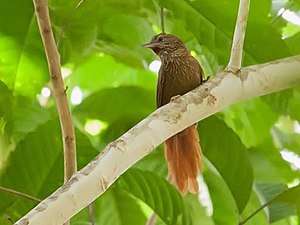Orinococanastero
| Orinococanastero | ||||||||||||
|---|---|---|---|---|---|---|---|---|---|---|---|---|

Orinococanastero ( Thripophaga amacurensis ) |
||||||||||||
| Systematics | ||||||||||||
|
||||||||||||
| Scientific name | ||||||||||||
| Thripophaga amacurensis | ||||||||||||
| Hilty , Ascanio & Whittaker , 2013 |
The Orinokocanastero ( Thripophaga amacurensis ) is a species of bird from the family of the potter birds (Furnariidae). It was discovered in Venezuela in 2004 and scientifically described in 2013 .
features
The Orinococanastero reaches a size of about 17 cm and a weight of 26 to 30 g. The male has light olive-sand colored feathers with dark gray tips on the reins. The rest of the head is dark, dull, brownish-olive. Each feather has a contrasting yellow-and-sand colored central stripe that gives it a crisp, speckled appearance. The spots are slightly larger and more contrasting on the cheek and under-beard stripes and narrower on the stripes above the eyes. The markings are long from the back of the head to the overcoat, so this area looks more streaked than spotted. The shoulder feathers and especially the area from the undercoat to the back are more plain and vivid brown. On the rump and on the upper tail-coverts the color changes into reddish brown or cinnamon-colored and on the upper wing coverts it becomes vivid olive-brown to reddish-yellow-brown. The inner lobes of the middle wing covers are mostly dull dark brown. The hems of the outer flags of the hand covers and most of the outside flags of the large arm covers are reddish-yellow-brown. The hand and arm wings are brownish with a lively brown border on the outer flags, which becomes increasingly wider towards the arm wings. The umbrella feathers are completely reddish brown. The under wing ceilings are reddish-orange, with the large ceilings being a bit lighter. The underside of the hand wings is slightly cinnamon-colored at the edge of the inner flags. On the inner arm wings, the color becomes lighter and changes into a broader cinnamon-sand color. The tail is simply cinnamon, the top of the tail is lighter and more reddish. The chin is cinnamon-sand colored. The throat is reddish-maroon. The neck and chest are brownish-olive, with each feather having a medium sand-colored teardrop-shaped mark. These markings are less well defined on the abdomen and completely fade on the flanks and thighs. The under tail covers are tinted more vividly, dark ocher yellow. The iris is reddish brown and surrounded by a narrow, featherless gray-olive eye ring. The bill is steel gray, somber at the base of the upper bill, lighter and slightly light flesh pink at the cleft and at the base of the lower bill. The tip of the beak is also often lighter. The legs are dull yellowish green.
Vocalizations
The singing is unmistakable and is usually performed in the form of a duet. It sounds like a long, clattering rattle made up of short, loud tones played by a bird (presumably the male). A second bird joins the song at different times, making rough, even shorter tones. After that, the volume and speed gradually decrease until the singing, which can still be heard at a considerable distance, is usually ended with a solo of the first bird singing. When the birds are aroused, the duets decrease in speed. Then they give way to a series of slower double or triple tones that continue in different periods before accelerating in another duet. The duets are easy to distinguish from those of the Strichelthroat canasteros ( Thripophaga cherriei ) and the cinnamon tail canasteros ( Thripophaga macroura ).
distribution
The Orinokocanastero is on the southern part of the Orinoco Delta in the State of Delta Amacuro in northern Venezuela endemic .
habitat
The Orinococanastero occurs in relatively old alluvial forests at low altitudes (about 20 to 25 m) near small streams and rivers, in an area where the forest is interspersed with a few small swamps and seasonally flooded savannas. Between May and October the riparian forest is flooded by two to four meters due to the season.
Way of life
The food is collected with simple picking movements. The Orinokocanastero digs in piles of rubble, in forks or in bundles of lianas and sometimes, like the bush panties ( Cranioleuca ) or the leaf scouts ( Philydor ), it searches for food along the tall branches with leaves and lianas.
literature
- Steven L. Hilty, David Ascanio & Andrew Whittaker: A new species of softtail (Furnariidae: Thripophaga) from the delta of the Orinoco River in Venezuela . In: Condor 115 (1): 143-154. The Cooper Ornithological Society 2013.
- Jon Fjeldså : Delta Amacuro Softtail. In: Josep del Hoyo , Andrew Elliott, Jordi Sargatal , David A. Christie (Eds.): Handbook of the Birds of the World: New Species and Global Index. Lynx edicions, 2013, ISBN 978-84-96553-88-0 , p. 211.
Web links
- Videos, photos and sound recordings of Thripophaga amacurensis in the Internet Bird Collection